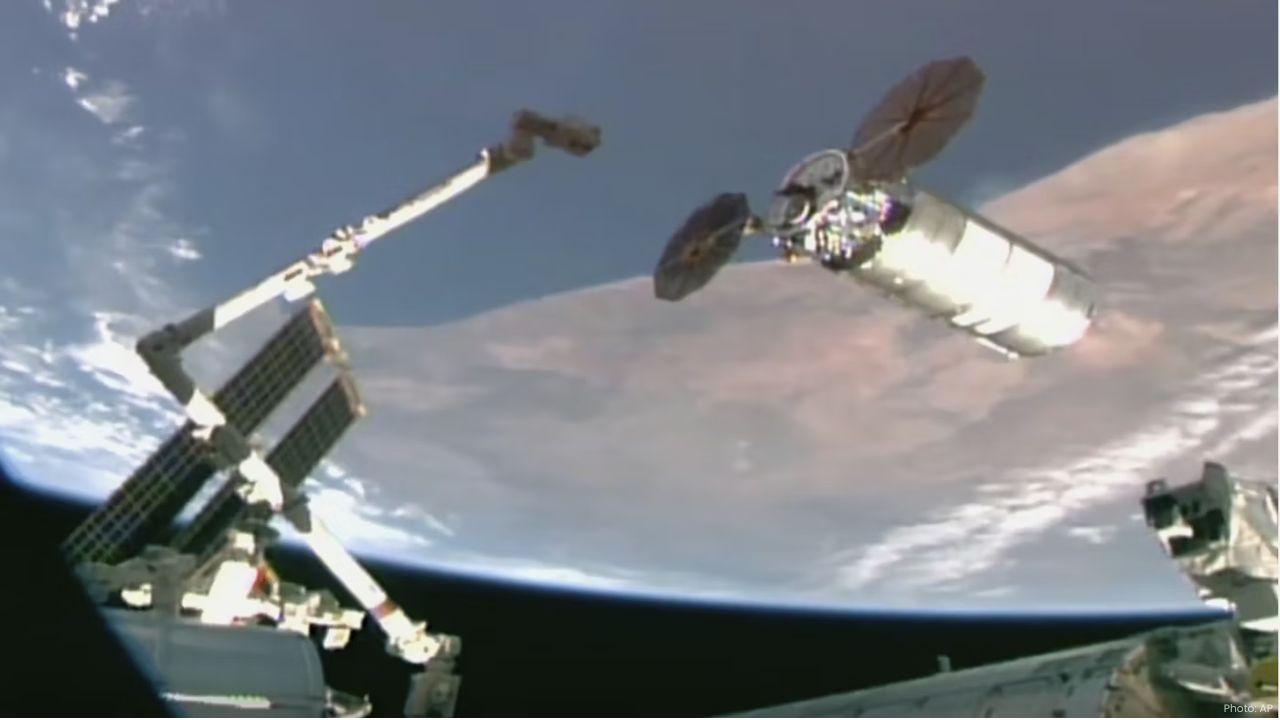
Post by : Meena Rani
On September 18, 2025, Northrop Grumman’s Cygnus XL cargo spacecraft successfully arrived at the International Space Station (ISS), a day later than originally scheduled. This mission is part of ongoing efforts to provide astronauts aboard the ISS with necessary supplies, scientific experiments, and equipment to support life and research in space.
The delay occurred due to an unexpected engine shutdown caused by a software safeguard designed to prevent potential damage. Despite this setback, the mission was completed safely, highlighting the careful planning and expertise of engineers and astronauts involved in space operations.
The Engine Issue
The Cygnus XL spacecraft launched from Earth on September 14, 2025, aboard a Falcon 9 rocket. During its journey to the ISS, the spacecraft needed to perform two burns with its main engine to adjust its orbit and align with the station. During these burns, the main engine shut down unexpectedly.
Engineers quickly determined that the shutdown was caused by a software safeguard that acted as a precaution to prevent any damage to the engine. Once the issue was resolved, the spacecraft resumed its journey and successfully approached the ISS. This incident demonstrates the complexity of space travel and how software and engineering systems are designed to protect the spacecraft and crew.
Astronauts’ Role in Docking
Even with the one-day delay, the astronauts aboard the ISS were prepared to receive the cargo ship. Using the station’s robotic arm, Canadarm2, NASA astronaut Jonny Kim and his fellow astronaut Zena Cardman carefully guided and captured the spacecraft as it passed over Africa.
After capturing Cygnus XL, the astronauts carefully berthed it to the Earth-facing port of the Unity module. This procedure requires precise coordination, patience, and skill, showcasing the training and expertise of astronauts working in the challenging environment of space.
Cargo Delivered
The Cygnus XL delivered approximately 11,000 pounds, or 5,000 kilograms, of supplies to the ISS. The cargo includes essential food, scientific experiments, spare parts, and maintenance equipment.
Some of the critical items delivered were components for the station’s life support systems, scientific instruments for ongoing research, and spare parts for systems such as the station’s toilets and air circulation units. These supplies are vital for the continued smooth operation of the ISS and for the comfort and safety of the astronauts living in space.
Honoring a Hero
The Cygnus XL was named S.S. William C. McCool in honor of the late astronaut William “Willie” McCool, who lost his life in the 2003 Space Shuttle Columbia disaster. McCool is remembered for his dedication, skill, and courage as a pilot and crewmember. Naming the spacecraft after him continues to inspire astronauts, engineers, and space enthusiasts around the world.
Significance of the Mission
This mission marked the debut of the Cygnus XL, an upgraded and larger version of the Cygnus cargo spacecraft. The XL version is approximately five feet longer than the previous models, which allows it to carry roughly 2,600 pounds more cargo. This upgrade significantly enhances NASA’s capability to resupply the ISS with essential items and support ongoing scientific research in orbit.
The mission also demonstrated the reliability of the spacecraft and the effectiveness of backup procedures and safeguards in addressing unexpected technical issues.
The Cygnus XL spacecraft is expected to remain attached to the ISS until March 2026. During this period, it will support the station by storing supplies, conducting experiments, and eventually serving as a platform for controlled disposal when its mission ends.
The success of this mission reinforces international cooperation in space exploration and highlights the continuous efforts to maintain and expand human presence in orbit. Every resupply mission ensures that the astronauts aboard the ISS can continue their research and live safely while advancing humanity’s understanding of life in space.
Cygnus XL, Northrop Grumman, International Space Station, ISS










Bengaluru-Mumbai Superfast Train Approved After 30-Year Wait
Railways approves new superfast train connecting Bengaluru and Mumbai, ending a 30-year demand, easi

Canada Post Workers Strike Halts Nationwide Mail and Parcel Services
Canada Post halts operations as CUPW strike disrupts mail and parcel delivery nationwide amid disput

PM Modi Launches BSNL ‘Swadeshi’ 4G Network, 97,500 Towers Built
India enters global telecom league as PM Modi inaugurates BSNL’s indigenous 4G, connecting 26,700 vi

India’s Iconic MiG‑21 Takes Final Flight After Six Decades of Service
After 60 years India retires its MiG‑21 fighter jet, a legendary yet controversial warplane marking

Hindustan Zinc unveils AI hotspot monitoring at Debari smelter
Hindustan Zinc launches AI-powered Switchyard Hotspot Monitoring at Debari smelter to cut outages bo

Chinese experts worked inside sanctioned Russian drone plant
Chinese drone specialists visited IEMZ Kupol supplying parts and drones via intermediaries, deepenin